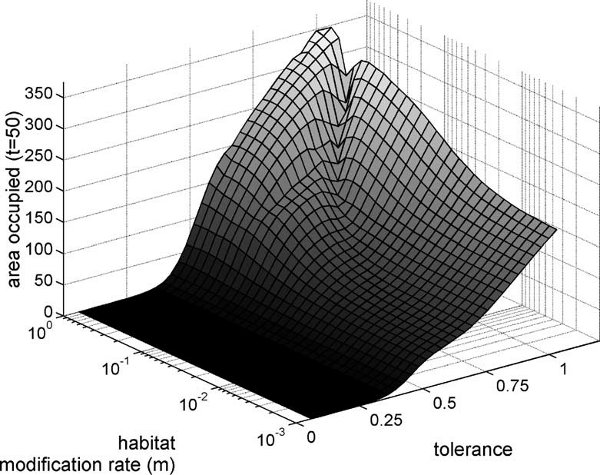Research interestsEcosystem engineeringMany important ecological relationships are non-trophic. For example, beavers build dams that determine the hydrology, species composition, and productivity of entire regions. However, almost all ecological theory regarding species interactions and population regulation ignores relations that occur via an abiotic medium. We are engaged in developing and parameterizing models of “ecosystem engineers” in an effort to establish the importance of this pervasive phenomena. |
 |
Climate and organism environment
Climate extremes are important for predicting the dynamics of populations, however, our understanding of weather variation is still incomplete. Most physical conditions, such as temperature, are autocorrelated, such that good or bad conditions persist over a period of time. We explore the effect of such temporally autocorrelated variation on populations. In addition, while the potential range and population dynamics of species can depend on climate conditions, sometimes simple measures of surface conditions do not describe the physical factors experienced by organisms. For example, tree-boring beetles which spend the winter months in the under-bark microclimate (eg, emerald ash borer, mountain pine beetle) may experience minimum temperatures that tend to be warmer than air, altering predicted growth rates and age of maturity. The ability to predict microclimate conditions from routine measures of weather conditions is essential when attempting to manage populations
Invasive species and extinction
The prediction of which species will become invasive, and which will which will go extinct is hampered by the failure to recognize the importance the variation of environmental conditions and ecosystem engineering. Positive autocorrelation in factors such as temperature may lead to “runs” of good or bad conditions that determine establishment probabilities and spread rates of non-native species. Moreover, some species may modify environmental conditions such that their success in increased. For example, the saltmarsh plant Spartina alterniflora alters current flow, sedimentation rates, and ultimately the tidal inundation height of those coastal regions where it occurs. We develop predictive tools of these phenomena and test them using both laboratory populations and field data.
Predator-prey population dynamics
Predator-prey dynamics are also altered by climate conditions and organism modification of the environment. Spatial structure in the environment, like the branching morphology of plants, may alter movement, predation, reproductive rates and ultimately, the dynamics, of predator-prey populations. The fundamental mechanism which causes these alterations appears to be the anomalously slow rates of displacement of randomly moving individuals in spatially complex environments. I'm testing whether this "diffusion-limitation" mechanism occurs in a well-controlled, yet realistic experimental system with biological control implications (peas-aphids-insect predators). The work suggests that we can design plants that optimize the ability of beneficial predators to control pests. However, sometimes one of the predator-prey pair is an engineering species. For example, burrowing crayfish may eat dragonfly larvae, and at the same time provide an aquatic refuge for the larvae during drought. We are developing models, doing lab experiments, and applying these ideas to the conservation of endangered species.
Philosophy of ecology
I am interested in the role of metaphor and mathematics in shaping ideas about ecology. I also explore how theories change in the discipline, and what parsimony might mean in the context of ecological theory.